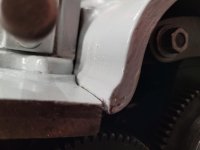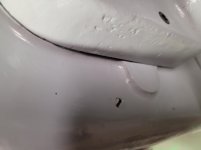Please see the images below. This is a gearbox that Dave Erickson refurbished and was kind enough to sell to me. I believe they are from within 1-2 years of each other from a manufacturing date. These pictures are of the gearbox in place, and all the bolts fully tightened. It doesn't appear to me to be a good fit. Any thoughts or suggestions welcome. I still have the original gearbox, which has some issues, and I can and will dis-assemble and inspect and clean and refurbish, but this was a quick way for me to get the 10EE back in action.
Gearbox not flush at bottom with base

Upper edge of gearbox not correctly aligned with headstock


Additionally, when putting the gearbox back together after partial dis-assembly, this threaded pin was the only thing left, and there was one threaded hole empty. AND since I didn't film or take pictures of the partial dis-assembly and there was two weeks in between, I don't have full recollection of whether this is correct.
What purpose is that pin serving anyway? When it is fully in place, it restricts the threads/feeds knob from functioning.
Threads/Feeds knob and threaded pin


Gearbox not flush at bottom with base

Upper edge of gearbox not correctly aligned with headstock


Additionally, when putting the gearbox back together after partial dis-assembly, this threaded pin was the only thing left, and there was one threaded hole empty. AND since I didn't film or take pictures of the partial dis-assembly and there was two weeks in between, I don't have full recollection of whether this is correct.
What purpose is that pin serving anyway? When it is fully in place, it restricts the threads/feeds knob from functioning.
Threads/Feeds knob and threaded pin











